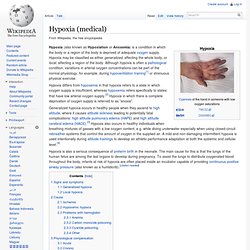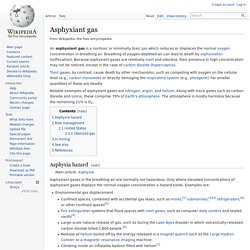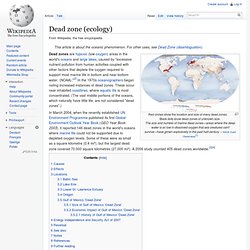

Blackdamp. Blackdamp (also known as stythe or choke damp) is an asphyxiant, reducing the available oxygen content of air to a level incapable of sustaining human or animal life.

It is not a single gas but a mixture of unbreathable gases left after oxygen is removed from the air and typically consists of nitrogen, carbon dioxide and water vapour. The suffix damp is believed to derive from the German word for vapours ("Dampf"). Space exposure. Space exposure is the subjection of a human to the conditions of outer space, without protective clothing and beyond the Earth’s atmosphere in a vacuum.

Explanation and history[edit] For the effect of rapid decompression to vacuum conditions, see the main article at Uncontrolled decompression. Ebullism, hypoxia, hypocapnia and decompression sickness[edit] Few humans have experienced these four conditions. Joseph Kittinger experienced localised ebullism during a 31 kilometres (19 mi) ascent in a helium-driven gondola.[1] His right-hand glove failed to pressurise and his hand expanded to roughly twice its normal volume[6][7] accompanied by disabling pain.
The only humans to have died of space exposure are the three crew members of the Soyuz 11 spacecraft: Vladislav Volkov, Georgi Dobrovolski and Viktor Patsayev. Inappropriate Content. Respiratory distress. Respiratory distress is difficulty in breathing, and the psychological experience associated with such difficulty, even if there is no physiological basis for experiencing such distress.

The physical presentation of respiratory distress is generally referred to as labored breathing, while the sensation of respiratory distress is called shortness of breath or dyspnea. Respiratory distress occurs in connection with various physical ailments, such as acute respiratory distress syndrome, a serious reaction to various forms of injuries to the lung, and infant respiratory distress syndrome, a syndrome in premature infants caused by developmental insufficiency of surfactant production and structural immaturity in the lungs. Symptoms may be outwardly evident, physically labored ventilation or respiratory efforts; clinically evident inability to adequately ventilate and/or oxygenate.
Hypoxia (medical) Hypoxia (also known as Hypoxiation or Anoxemia) is a condition in which the body or a region of the body is deprived of adequate oxygen supply.

Hypoxia may be classified as either generalized, affecting the whole body, or local, affecting a region of the body. Although hypoxia is often a pathological condition, variations in arterial oxygen concentrations can be part of the normal physiology, for example, during hypoventilation training[1] or strenuous physical exercise. Hypoxia differs from hypoxemia in that hypoxia refers to a state in which oxygen supply is insufficient, whereas hypoxemia refers specifically to states that have low arterial oxygen supply.[2] Hypoxia in which there is complete deprivation of oxygen supply is referred to as "anoxia".
Hypoxia is also a serious consequence of preterm birth in the neonate. The main cause for this is that the lungs of the human fetus are among the last organs to develop during pregnancy. Extreme pain may also be felt at or around the site. Asphyxia. Asphyxia or asphyxiation (from Ancient Greek α- "without" and σφύξις sphyxis, "heartbeat") is a condition of severely deficient supply of oxygen to the body that arises from abnormal breathing.

An example of asphyxia is choking. Asphyxia causes generalized hypoxia, which affects primarily the tissues and organs. There are many circumstances that can induce asphyxia, all of which are characterized by an inability of an individual to acquire sufficient oxygen through breathing for an extended period of time. Asphyxiant gas. An asphyxiant gas is a nontoxic or minimally toxic gas which reduces or displaces the normal oxygen concentration in breathing air.

Breathing of oxygen-depleted air can lead to death by asphyxiation (suffocation). Because asphyxiant gases are relatively inert and odorless, their presence in high concentration may not be noticed, except in the case of carbon dioxide (hypercapnia). Toxic gases, by contrast, cause death by other mechanisms, such as competing with oxygen on the cellular level (e.g., carbon monoxide) or directly damaging the respiratory system (e.g., phosgene).
En.wikipedia. Red circles show the location and size of many dead zones.

Black dots show dead zones of unknown size.The size and number of marine dead zones—areas where the deep water is so low in dissolved oxygen that sea creatures can't survive—have grown explosively in the past half-century. – NASA Earth Observatory[1] In March 2004, when the recently established UN Environment Programme published its first Global Environment Outlook Year Book (GEO Year Book 2003), it reported 146 dead zones in the world's oceans where marine life could not be supported due to depleted oxygen levels. Some of these were as small as a square kilometre (0.4 mi²), but the largest dead zone covered 70,000 square kilometres (27,000 mi²). A 2008 study counted 405 dead zones worldwide.[3][4] Climate has a significant impact on the growth and decline of ecological dead zones.
Internationally celebrated limnologist Dr. Additionally, natural oceanographic phenomena can cause deoxygenation of parts of the water column. Anoxia. Hypoventilation. Causes[edit] It can be caused by medical conditions, such as stroke affecting the brainstem, by holding one's breath, like during hypoventilation training,[2] or by drugs, typically when taken in overdose.

Hypocapnia stimulates hypoventilation.